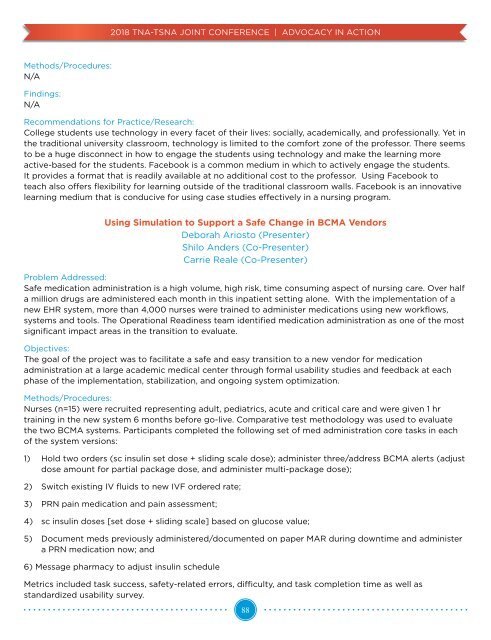2018 TNA and TSNA Joint Annual Conference
Create successful ePaper yourself
Turn your PDF publications into a flip-book with our unique Google optimized e-Paper software.
<strong>2018</strong> <strong>TNA</strong>-<strong>TSNA</strong> JOINT CONFERENCE | ADVOCACY IN ACTION<br />
Methods/Procedures:<br />
N/A<br />
Findings:<br />
N/A<br />
Recommendations for Practice/Research:<br />
College students use technology in every facet of their lives: socially, academically, <strong>and</strong> professionally. Yet in<br />
the traditional university classroom, technology is limited to the comfort zone of the professor. There seems<br />
to be a huge disconnect in how to engage the students using technology <strong>and</strong> make the learning more<br />
active-based for the students. Facebook is a common medium in which to actively engage the students.<br />
It provides a format that is readily available at no additional cost to the professor. Using Facebook to<br />
teach also offers flexibility for learning outside of the traditional classroom walls. Facebook is an innovative<br />
learning medium that is conducive for using case studies effectively in a nursing program.<br />
Using Simulation to Support a Safe Change in BCMA Vendors<br />
Deborah Ariosto (Presenter)<br />
Shilo Anders (Co-Presenter)<br />
Carrie Reale (Co-Presenter)<br />
Problem Addressed:<br />
Safe medication administration is a high volume, high risk, time consuming aspect of nursing care. Over half<br />
a million drugs are administered each month in this inpatient setting alone. With the implementation of a<br />
new EHR system, more than 4,000 nurses were trained to administer medications using new workflows,<br />
systems <strong>and</strong> tools. The Operational Readiness team identified medication administration as one of the most<br />
significant impact areas in the transition to evaluate.<br />
Objectives:<br />
The goal of the project was to facilitate a safe <strong>and</strong> easy transition to a new vendor for medication<br />
administration at a large academic medical center through formal usability studies <strong>and</strong> feedback at each<br />
phase of the implementation, stabilization, <strong>and</strong> ongoing system optimization.<br />
Methods/Procedures:<br />
Nurses (n=15) were recruited representing adult, pediatrics, acute <strong>and</strong> critical care <strong>and</strong> were given 1 hr<br />
training in the new system 6 months before go-live. Comparative test methodology was used to evaluate<br />
the two BCMA systems. Participants completed the following set of med administration core tasks in each<br />
of the system versions:<br />
1) Hold two orders (sc insulin set dose + sliding scale dose); administer three/address BCMA alerts (adjust<br />
dose amount for partial package dose, <strong>and</strong> administer multi-package dose);<br />
2) Switch existing IV fluids to new IVF ordered rate;<br />
3) PRN pain medication <strong>and</strong> pain assessment;<br />
4) sc insulin doses [set dose + sliding scale] based on glucose value;<br />
5) Document meds previously administered/documented on paper MAR during downtime <strong>and</strong> administer<br />
a PRN medication now; <strong>and</strong><br />
6) Message pharmacy to adjust insulin schedule<br />
Metrics included task success, safety-related errors, difficulty, <strong>and</strong> task completion time as well as<br />
st<strong>and</strong>ardized usability survey.<br />
88

















